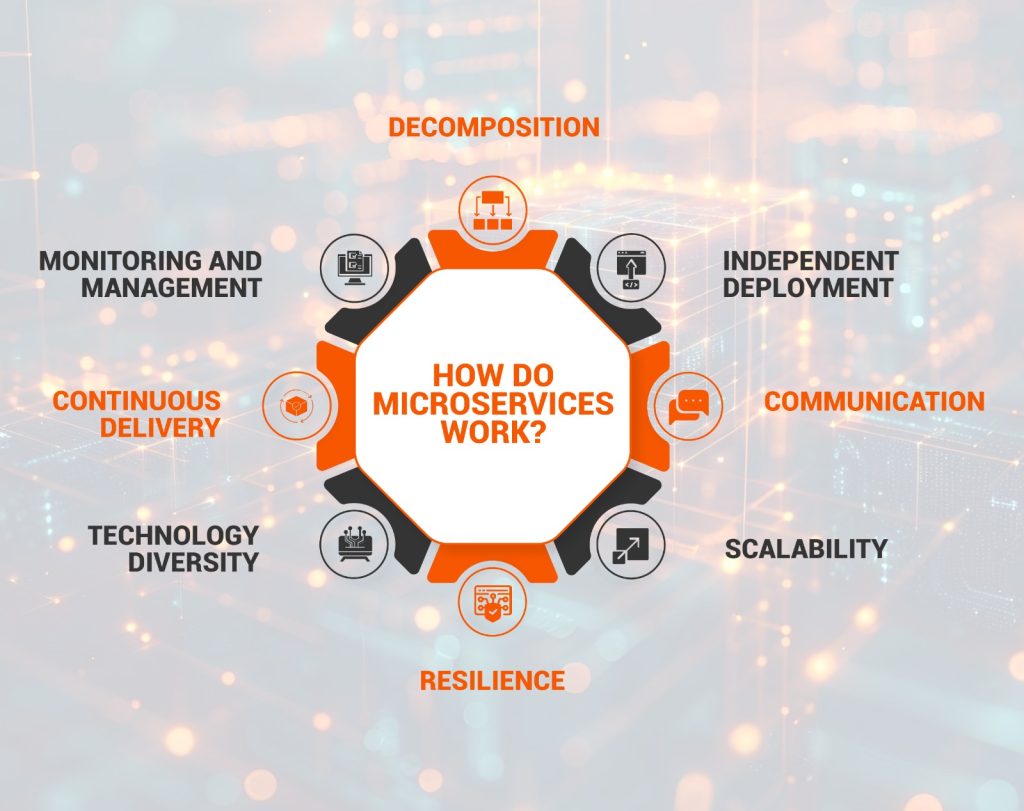Imagine you have a large, complex machine. Instead of one giant piece, what if you could break it into smaller, manageable parts that can work independently but still come together perfectly? This is the idea behind microservices. This approach enables developers to build applications as a collection of these self-contained, autonomous services in software development. Each service performs a specific function, making building, maintaining, and scaling applications easier.
I’m here to guide you through microservices and uncover their incredible benefits. Let’s get started!
What Are Microservices?
A microservice is a compact, loosely connected service that handles a specific business function. Each microservice operates independently, which means it can be developed, deployed, and scaled independently. This approach helps decompose a large application into smaller, more manageable parts, each with its own specific role. Microservices architecture is essential for contemporary applications, allowing each component to function as an independent mini-application. They can be developed using various programming languages and frameworks, each contributing to the system’s functionality.
How Do Microservices Work?
Microservices break down an extensive application into more minor, independent services that can be developed, deployed, and maintained separately. Each microservice focuses on a business function and communicates with other services through APIs. Here’s a simplified explanation of how they work:

- Decomposition: The application is divided into more minor services, each responsible for a specific function (e.g., user management, order processing, payment service).
- Independent Deployment: Microservices can be developed, tested, and deployed independently, enabling teams to work on different application parts concurrently without impacting one another.
- Communication: Microservices interact with one another via clearly defined APIs, usually utilizing HTTP/REST or messaging queues. This allows them to exchange data and coordinate actions.
- Scalability: Each service can be scaled independently according to demand. For example, if there is a surge in traffic to the order processing service, it can be scaled up independently without needing to scale the entire application.
- Resilience: Since each microservice operates independently, a failure in one won’t necessarily impact the rest of the system. This isolation enhances the overall resilience of the application.
- Technology Diversity: Different services can use different programming languages, databases, and frameworks best suited for their specific tasks, allowing for greater flexibility and innovation.
- Continuous Delivery: Microservices facilitate continuous integration and delivery (CI/CD) practices, enabling faster updates and more frequent releases.
- Monitoring and Management: Effective monitoring and management tools are essential to track the health and performance of each service, ensuring smooth operation and quick identification of issues.
Facts You Should Know About Microservices
- The global market for microservices architecture was valued at USD 4.10 billion in 2022. It is expected to grow to USD 18.46 billion by 2031, with a CAGR of 18.2% projected from 2023 to 2031.
- According to Statista, 40% of respondents using microservices deemed them extremely important for organizational operations, with a majority of 54% agreeing that they were essential in the same year.
Components of Microservices Architecture
Microservices architecture consists of various components collaborating to build a modular, scalable, and independently deployable system. Critical components of microservices include:
Microservices
- Definition: Microservices are small, self-contained services that perform a specific business function or capability. Each microservice handles a particular application function, like user management, payment processing, or inventory control.
- Characteristics: They are loosely coupled, meaning they operate independently. This provides increased flexibility, scalability, and simplified maintenance. They often follow the principles of domain-driven design to encapsulate specific business domains.
API Gateway
- Definition: An API Gateway is a single entry point for all client requests. It handles routing, load balancing, authentication, and sometimes, request transformation.
- Functions: It simplifies client interactions by providing a unified API surface, abstracts the complexity of the underlying microservices, and ensures that service requests are appropriately routed and managed. It can also offer additional features like caching and rate limiting.
Service Discovery
- Definition: Service Discovery enables microservices to dynamically find and communicate with each other without hardcoding their network locations.
- Mechanism: It typically involves a service registry where services register themselves and a discovery service that allows other services to query the registry to find instances of services. Standard tools include Consul, Eureka, and Zookeeper.
Load Balancer
- Definition: A Load Balancer distributes incoming network or application traffic across multiple instances of a microservice to ensure no single instance is overwhelmed.
- Purpose: It enhances the availability and reliability of applications by balancing the load and enabling horizontal scaling. Load balancing can be implemented at different levels, such as DNS, HTTP, or TCP.
Database
- Definition: Each microservice generally maintains its database in a microservices architecture. This design ensures that services remain independent, allowing them to be developed, deployed, and scaled separately.
- Types: Databases can be relational (SQL) or non-relational (NoSQL), depending on the service’s needs. Each microservice owns and manages its data, reducing the risk of database contention and improving data consistency.
CI/CD Pipeline
- Definition: Continuous Integration (CI) and Continuous Deployment (CD) pipelines automate integrating code changes and deploying them to production.
- Benefits: CI/CD pipelines streamline the development workflow, ensuring code changes are automatically tested and deployed. This enhances the agility of development teams and reduces the risk of deployment errors.
Monitoring and Logging
- Definition: Monitoring and logging involve tracking microservices’ performance, health, and behaviour. Monitoring tools collect metrics while logging tools capture detailed logs of service operations.
- Tools: Common monitoring tools include Prometheus and Grafana while logging tools include ELK Stack (Elasticsearch, Logstash, Kibana) and Splunk. They help identify issues, understand service behaviour, and ensure system reliability.
Security
- Definition: Security in microservices involves ensuring secure communication, protecting data, and implementing proper authentication and authorization mechanisms.
- Strategies include: Securing APIs using OAuth2 or JWT tokens, encrypting data in transit and at rest, and implementing role-based access control (RBAC). Security practices are crucial to protecting the integrity and confidentiality of services and data.
Containerization and Orchestration
- Definition: Containerization involves packaging microservices and their dependencies into containers to ensure consistency across different environments. Orchestration manages the deployment, scaling, and operation of these containers.
- Tools: Docker is commonly used for containerization, while Kubernetes is widely used for orchestration. These tools simplify the deployment process, manage the container lifecycle, and provide scalability and resilience for microservices.
Examples of Microservices
Are you curious about how this works in real-world scenarios? Let’s explore some examples of microservices in action. The companies below leveraged microservices architecture to tackle critical scaling and server processing challenges.
Consider the microservices architecture example: Netflix transitioned from a monolithic structure to a Service-Oriented Architecture (SOA). Netflix’s streaming video API handles over a billion calls from approximately 800 devices daily. Each API call triggers around five additional back-end development service requests.
Similarly, Amazon has adopted a microservices approach. Their previous two-tiered architecture couldn’t manage the high volume of calls from various applications, including those interacting with the web service API and the website.
Future of Microservice Architecture
Whether or not microservice architecture becomes the preferred development approach in the future, it undeniably offers considerable benefits for building and deploying enterprise applications.
Many organisations and developers have been using strategies akin to microservices, leveraging APIs without explicitly labelling their practice as SOA.
Microservices architecture is seen as the future due to its apparent advantages over monolithic architectures, such as enhanced modularity, scalability, and maintainability. They align well with CI/CD practices, which are crucial today.
Moreover, microservices facilitate faster development and shorter time-to-market. They allow developers to focus on individual components rather than integrating everything into a single, complex, monolithic application.
Developers must acquire new skills and technologies as businesses transition from monolithic to microservices. However, the substantial benefits of this architecture make the investment worthwhile.
Nirvana Lab Expertise with Micro-Services Development
At Nirvana Lab, we redefine micro-services development with unparalleled expertise. Our innovative approach dissects complex applications into agile, independently deployable modules, enhancing scalability, flexibility, and maintenance. This method streamlines updates and minimizes downtime, ensuring your systems remain robust and high-performing. By incorporating the latest technologies and industry-leading practices, we create customized solutions that speed up your time-to-market and enhance user experiences. Focusing on innovation and efficiency, Nirvana Lab transforms your vision into agile, scalable solutions that drive growth and operational excellence.
Frequently Asked Questions
What are microservices?
Microservices architecture are small, independent services that handle specific functions within an application. They can be developed, deployed, and scaled independently, allowing for easier management of complex applications by breaking them down into smaller, more manageable components.
How do microservices communicate with each other?
Microservices communicate through APIs, using HTTP/REST or messaging queues. This allows them to exchange data and coordinate actions efficiently.
What makes Nirvana Lab’s microservices development approach unique?
Nirvana Lab’s microservices development stands out for its innovative and agile approach. We break down complex applications into independent, deployable modules, enhancing scalability, flexibility, and ease of maintenance. Our method integrates advanced technologies and best practices to ensure efficient updates, reduced downtime, and high-performing systems tailored to your needs.
What are the benefits of using microservices architecture?
Microservices offer flexibility, scalability, and easier maintenance. They allow different parts of an application to be updated or scaled independently and improve overall system resilience by isolating failures.
How do microservices improve application scalability?
Microservices allow each component to be scaled independently based on its specific needs. For example, if one service faces increased traffic, it can be scaled up independently without impacting the other services.
What tools are used for managing microservices?
Tools like Docker and Kubernetes are used for containerization and orchestration, helping manage microservices’ deployment, scaling, and operation. Monitoring and logging tools like Prometheus and ELK Stack are also crucial for maintaining system health.
